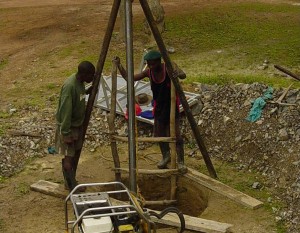November 2010
Where is poverty? In 2008, the World Bank determined the poverty line as living on less than $1.25 a day. Internationally, one in four people are living on less than $1.25 a day (according to World Bank results in 2008); which is down from one in two in 1981. These statistics indicate that we are improving towards our goal to eliminate poverty, however progress is uneven across regions:
Asia has improved in their process and because of it’s large population has a strong influence on global statistics. Therefore, the progress of both Africa and Latin America are not accurately reflected in the global numbers. According to the most recent statistics more than 80% of the population lives below the poverty line in the countries of Liberia, Gaza Strip, Haiti, Zimbabwe, and Chad; and more than 70% on Sierra Leone, Suriname, Mozambique, Angola, and Nigeria. Still, there are another 18 countries with more that 50% of their population in extreme poverty.
Movement to End Poverty
On October 17, 1987 more than 100, 000 people gathered to honor victims of extreme poverty, violence, and hunger, in Paris, France. This movement stimulated a chain of events, which ultimately lead to Millennium Summit in 2000 where world leaders, from 189 countries, committed themselves to cutting the number of people living in extreme poverty in half by 2015.
“Worldwide, 1.4 billion people earn less than $1.25 a day. This is a frightening statistic, but it’s a reality.” (Daniel Germain, the Summit’s president and founder)
In 2005, under the banner of MAKEPOVERTYHISTORY, millions of people supported the campaign that pushed governments to ensure that global poverty was placed higher on the national and global agenda than ever before. Make Poverty History was just one of 84 national coalitions calling for a breakthrough on poverty in 2005. This movement became known as the Global Campaign Against Poverty (GCAP). As a result, there was an extra $48 billion a year in commitments from the 2005 G8 summit.
These advancements have been great, however, there is still a lot to be done. Still, these movements indicate that there is a huge international desire to end poverty, and as we collaborate and work together we are making a difference.
Investologist Prognostication
Jeremy Leonard
Quote:
“Supporting most bears right now is a bunch of bull: namely, the notion that too much debt will bite us in the butt. Since last fall the guts underlying gloom and doom market forecasts have been disproven one by one.Excessive debt is the main argument the bears still hug.
Which is one reason the bull market has a long way to run – the bears are basing their case on a wrong argument.Debt doomers come in varying styles.There is the banking crisis style and the real estate implosion style – often linked, as in “falling real estate prices will bankrupt the banks, which will cause chaos.” Then, too, are those noting the “tapped-out consumer” who can’t or won’t borrow, thereby causing an anemic recovery or no recovery, or finally, the pseudo-sophisticate’s favorite – the double dip recession.”
Written by Ken Fisher in August 1991 and again in his column in Forbes this month
Buys:
DPVC Incorporated, DPV-V, is now Titanstar Properties, TSP-V.I still have buy orders on dips. (This security is held by only a few people and is not liquid. Rick Turner is the President, CEO, and Manager. So it is really a play on Rick Turner and his friends, who hold the vast majority of the stock. Definitely a speculation, not an investment).

